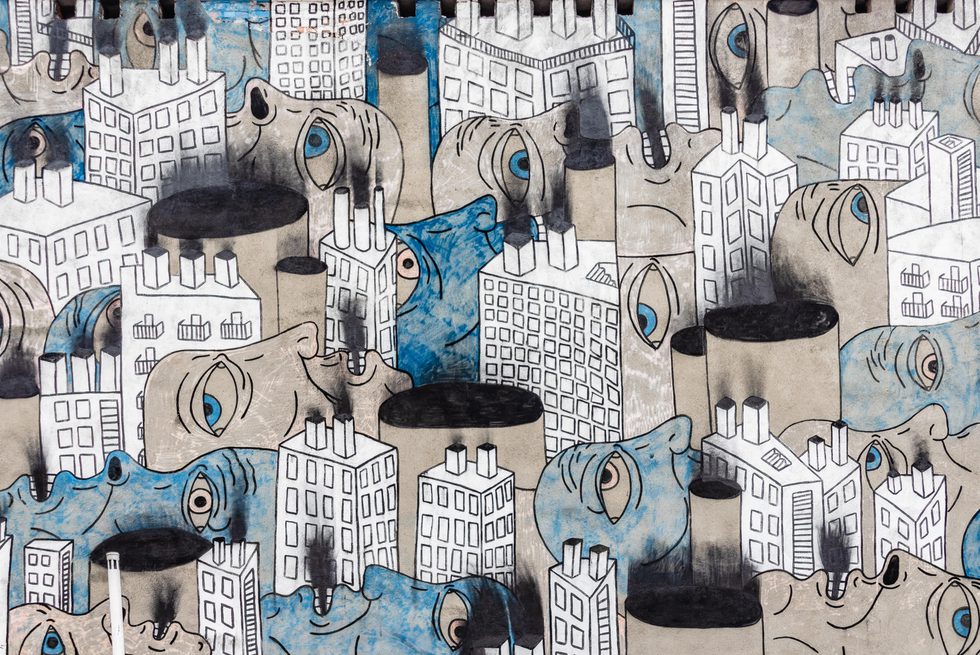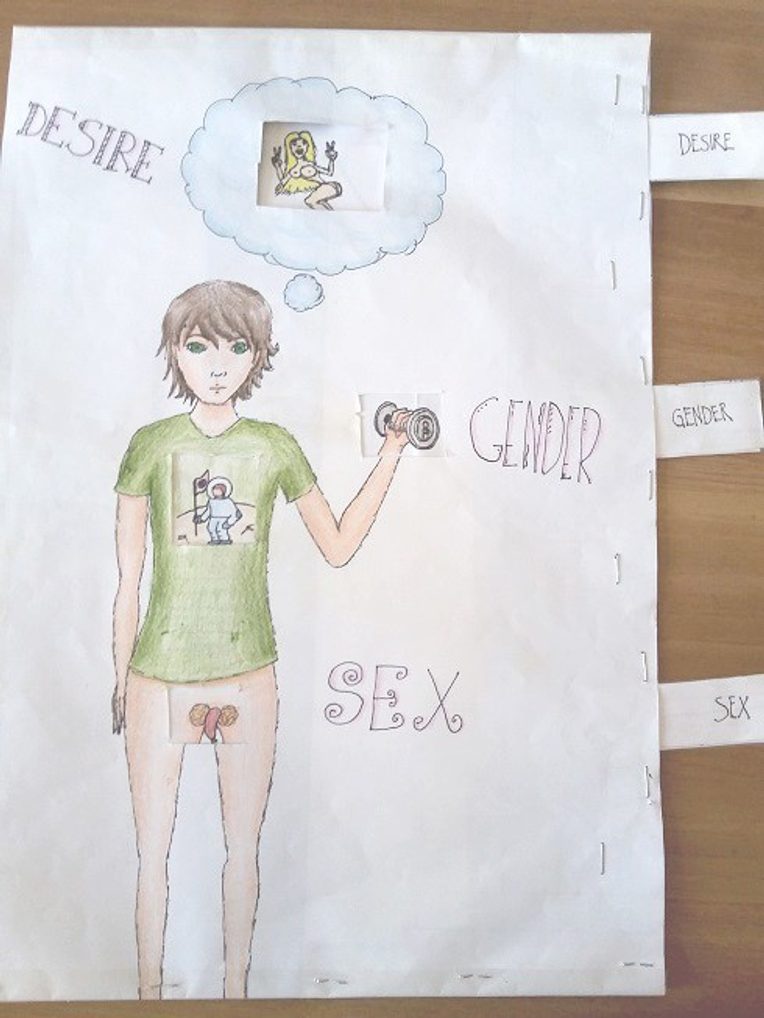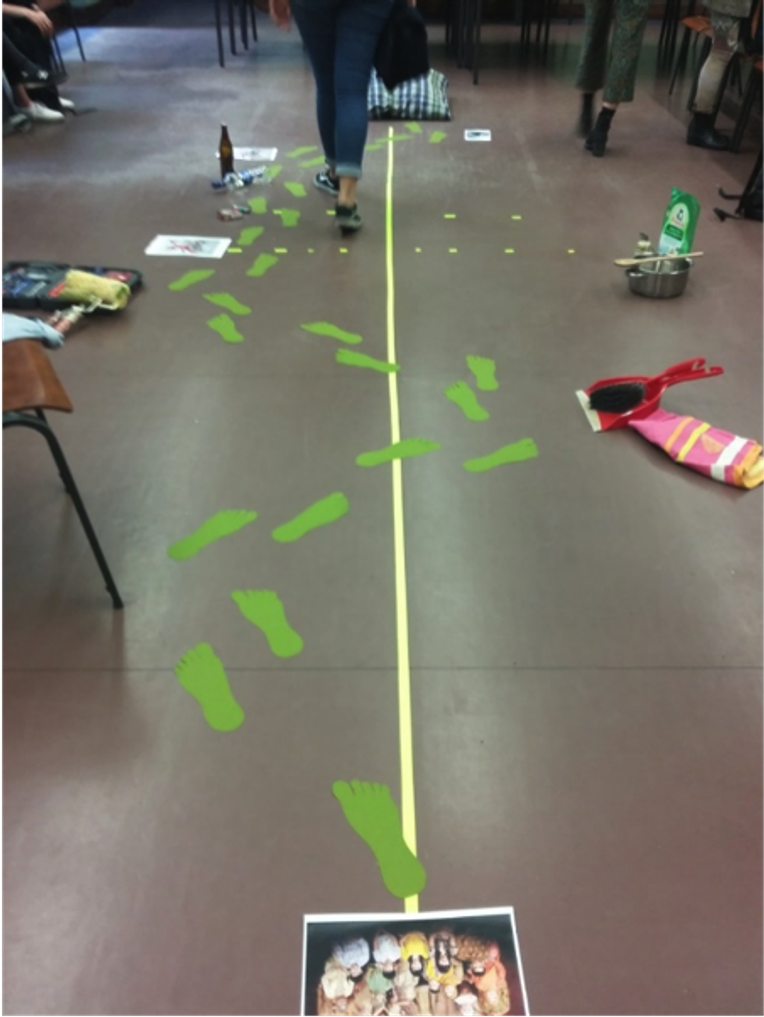
My previous post introduced “Envisioning Theory,” a teaching experiment in which students produced visualizations of scholarly texts. My co-teacher and I pursued two aims with this experiment. First, we hoped to enliven the (sometimes quite detached) format of the theory seminar, rendering it more accessible. Second, we aspired to address bodiliness as a core approach and experience critical to a course on the anthropology of the body. Extending those reflections, this post shares a few insights into the types of visuals that students created in response to academic texts. While we left the format and materials undefined, we found that students tended to pursue this task in one of three ways: by visually reducing the text, by mapping its complexity, or by performing it.
Visual Reduction
“Envisioning Theory” produced pictorial accounts that displayed simplicity without being schematic. One student, for instance, visualized what Judith Butler (1999, 9-10) calls the “compulsory order” or “mimetic relation” between desire, gender, and sex. This order works by means of heteronormative binaries that regulate societal expectations by which a (presumably prediscursive) anatomical male equals a social male who desires females. The student drew a picture of a anatomically nonidentifiable figure whose genitals switch from normatively male to normatively female when pulling a small tab at the side. To the spectator’s surprise, the figure’s (social) gender (situated in the hand) and the subject of desire (in the brain) change unwittingly. The masculine symbol of a barbell morphs into a womanly bracelet and a naked woman into a surfer boy. The visualization conveys Butler’s conception of the social inseparability and binary character of sex/gender/desire in a beautifully straightforward way.

Another group of students visualized a chapter of Susan Bordo’s (1993) book Unbearable Weight. Bordo suggests that anorexia and obesity are not exceptions, but allegories or crystallizations of contemporary Western culture. By declaring these to be extremes that are out of the norm, popular discourse conceals the normalizing power of slender ideals and of disciplining technologies such as diet and body management. The students combined two pictures—one of a heavier woman and one of a woman who was just skin and bones—and added the terms Verlangen (desire) and Kontrolle (control). Our gaze moved from the person on the left to the one on the right, thus recreating what Bordo critically frames as a pendulum that expects both the maintenance of posture and letting go. These and other visualizations were quite powerful in visual terms: a singular message, expressed through vital visual material.
Complex Mapping
Some students struggled with the notion of a radical visual reduction discussed above. Their difficulty was linked with the density of the scholarly text. Scholars tend to express multiple ideas, rather than just one, and usually ground their arguments in debates about which undergraduates have only rudimentary knowledge. We thus received a few presentations that were highly textual and dense, such as this visual map.

This map departs from the visual plainness and immediate readability of the examples above. Nevertheless, it involves sophisticated conceptual work. The group identified major ideas in Lisa Law’s (2001) text on Filipino women in Hong Kong, such as the production of Little Manila as a home-like space and the diverse ways of relating to past and family. Such an assemblage fits well into a discipline oriented toward complexity, connection, and interrelatedness, marked by a writing practice that never stops deconstructing established claims. We spent considerable time on these mapped visualizations and paused to trace individual linkages. While they provided us with a lot of nuance, we as instructors had to direct the discussion toward a central idea, such as the formulation of power/resistance through Little Manila. Because such central messages were hard to grasp from the visualization alone, we had to take a more active role in the discussion to make sure that students understood the main points of the text.
Bodily Performances
Other projects provoked spontaneous and intense experiential and emotional engagement. Here, the central message was not conveyed instantly, but rather unfolded during a performance. And whereas the other two styles of visualization occupied a small terrain (a piece of paper or a picture projected on a wall), students here filled the entire classroom and made use of their peers as subjects and objects in a scene. One such project was provoked by an essay on tomboi embodiment by Evelyn Blackwood (2011), which introduces readers to the mundane worlds of transgender people in Indonesia. Blackwood suggests that identitary essentials play a less important role in the world of tombois who, in this study at least, swap role identities without perceiving this practice as contradictory. The students visualized role shifts by means of footprints traversing a line and different materials associated with gendered activities. The line emerged as a subject for debate: Should we destabilize it, rip it into pieces, create loopholes? Who is creating the line and how is it being reproduced?

The student presenters drew on the curiosity of their peers and invited them to pursue sets of actions that staged an analytical theme of the text. Such an integrative approach effectively employed bodily learning and performatively recreated the author’s own fieldwork experiences.
The Challenges of Facilitating Visualization
The examples discussed above show how visualizations might be used as a pedagogical technique to enliven theory classes and to diversify the ways in which students engage with scholarly work. And yet “Envisioning Theory” came with a set of challenges. The most obvious one was a kind of mimicking effect: later presentations tended to pick up some of the visualization ideas presented in earlier sessions.

These images make it clear that the visualizations on Malaysian kinship (middle photo) and tomboi embodiment (on the right) followed the visual vocabulary set by an earlier project about egg-cell donation in Romania (on the left). Of course, anthropological texts often speak in spatial terms and therefore lend themselves to visualizations along these lines. They speak about discursive or ethical boundaries and their crossing, societal segmentation and processes of exchange, so that spatial metaphors did make sense for several of the texts. In unexpected ways, students revealed that they had learned a lot about the tropes of anthropological writing as they staged scenes of de/fragmentation.
It was also difficult, for me at least, to avoid making judgments about the creative extent of these realizations and about how well they showed theory. I had to learn to be flexible and appreciative. Visualization exercises demand creativity not just from the students but also from instructors who spontaneously have to “see” how visualizations speak (or not) to the text, while also taking note of blank spaces that needed to be filled in. This burden lies with instructors, who must both facilitate text-based discussion and integrate visual responses that they cannot forecast or control (without short-circuiting the creative space at the center of this experiment). In sum, visualization exercises—because they need to be prepared, introduced, consulted, and evaluated—inevitably create some extra work for lecturers. Yet they may also help us to move closer toward using the classroom as a space for bodily learning, expanding our modes of teaching and growing professionally as flexible and attentive educators.
References
Blackwood, Evelyn. 2011. “Tomboi Embodiment.” In A Companion to the Anthropology of the Body and Embodiment, edited by Frances E. Mascia-Lees, 207–222. Malden, Mass.: Wiley-Blackwell.
Bordo, Susan. 1993. Unbearable Weight: Feminism, Western Culture, and the Body. Berkeley: University of California Press.
Butler, Judith. 1999 [1990]. Gender Trouble: Feminism and the Subversion of Identity. New York: Routledge.
Law, Lisa. 2001. “Home Cooking: Filipino Women and Geographies of the Senses in Hong Kong.” Ecumene 8, no. 3: 264–83.